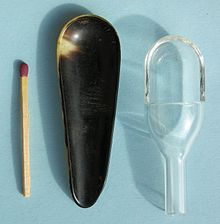Weighing pan
A weighing pan , also known as a weighing boat , is needed in the laboratory as an aid to weigh reagents and ingredients. They are open-topped bowls or elongated boats into which the reagents or ingredients are filled when weighing. This protects the weighing pan of the often sensitive scale .
Executions
- Weighing pans made of aluminum (e.g. 100 × 7 mm)
- Weighing pans made of stainless steel
- Weighing pans (weighing jars) made of glass
- Porcelain weighing bowls
- Weighing bowls made of horn (no longer common today)
- Weighing pans made of impact-resistant polystyrene (PS) are antistatic. There are square, rectangular, diamond, and hexagonal shapes.
The latter have a smooth surface that enables precise pouring with minimal sample loss. They are biologically inert and resistant to dilute and weak acids , aqueous solutions, alcohols and alkalis . These flexible boats can be squeezed together in several places to form a pouring spout. They have a flat bottom for high stability, have sloping sides for precise decanting and are temperature-resistant up to 70 ° C. They are offered in different sizes.
Individual evidence
- ↑ Kathy Barker: The Cold Spring Harbor Laboratory Guide for Beginners . 1st edition. Elsevier, Munich 2006, ISBN 978-3-8274-1656-8 , pp. 135-136.
- ^ Walter Wittenberger: Chemische Laboratoriumstechnik , Springer-Verlag, Vienna, New York, 7th edition, 1973, p. 79, ISBN 3-211-81116-8 .
